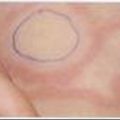16.6 Nephrotic syndrome
Pathophysiology
There is also evidence in some patients for primary salt and water retention by the kidney.
Investigations
Treatment
Complications
Acute complications occur in two groups of patients:
The tendency to develop infections is a true complication of the disease.
Prevention
As the primary causes of idiopathic nephrotic syndrome are unknown, there is no means of prevention.
Bergstein J. Conditions particularly associated with proteinuria. In: Behrman R., Kliegman R., Jenson H., editors. Nelson’s textbook of pediatrics. 16th ed. Philadelphia: WB Saunders; 2000:1592-1596.
Cronan K., Norman M. Renal and electrolyte emergencies. In: Fleisher G., Ludwig S., editors. Textbook of pediatric emergency medicine. 4th ed. Philadelphia: Lippincott Williams & Wilkins; 2000:832-835.
Falk R.J., Charles Jennette J., Nachman P.H. Nephrotic syndrome. Brenner B., editor. The kidney, 6th ed, vol. 2. Philadelphia: WB Saunders, 2000;1266-1283.
Gipson D.S., Massengill S.F., Yaol L., et al. Management of childhood onset nephrotic syndrome. Pediatrics. 2009;124:747-757.
Grimbert P., Audard V., Remy P., et al. Recent approaches to the pathogenesis of minimal-change nephrotic syndrome. Nephrol Dial Transpl. 2003;18:245-248.
Kaysen G.A. Proteinuria and the nephrotic syndrome. In: Schrier R.W., editor. Renal and electrolyte disorders. 6th ed. Philadelphia: Lippincott, Williams & Wilkins; 2003:580-614.
Roth K.S., Amaker B.H., Chan J.CM. Nephrotic syndrome: Pathogenesis and management. Pediatr Rev. 2002;23:237-247.





